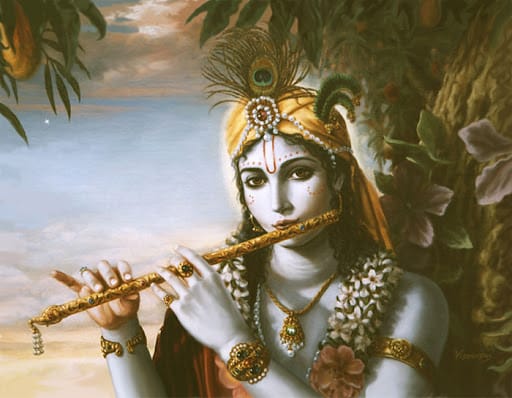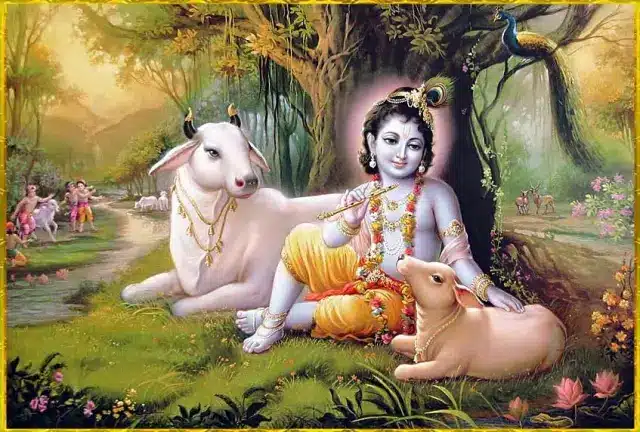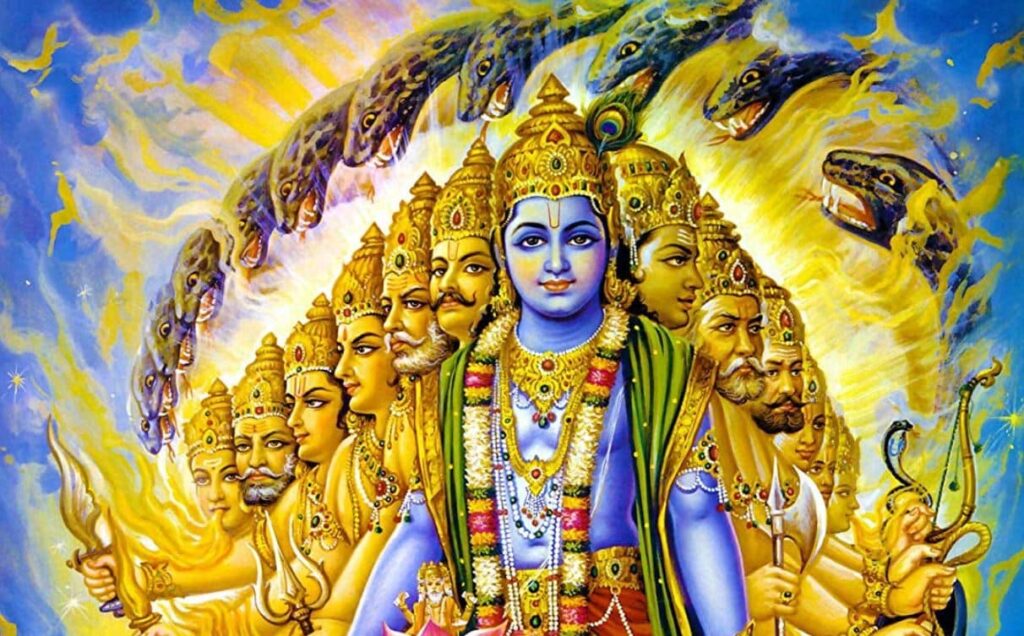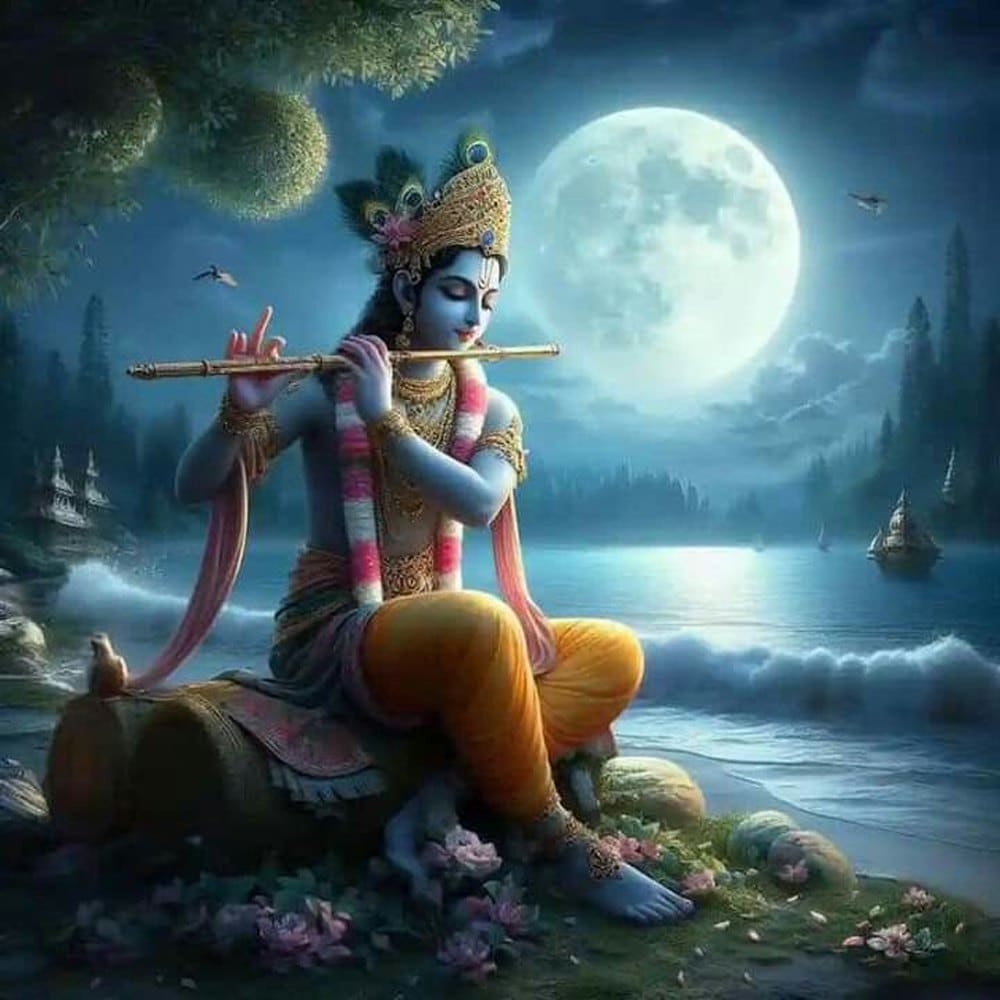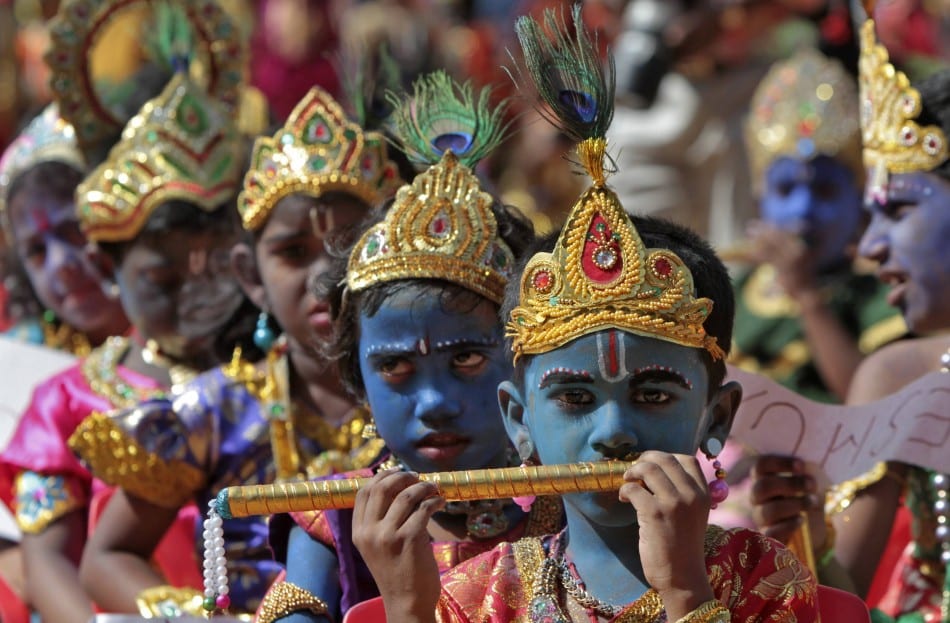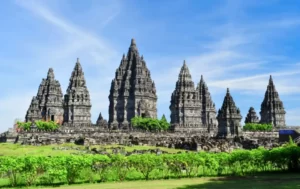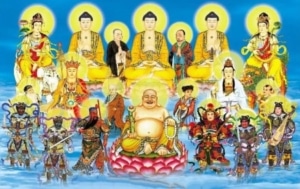Krishna is typically depicted with a dark or blue skin tone, symbolizing the infinite and the divine. He is often shown wearing a peacock feather in his hair, which represents beauty and knowledge. His attire usually consists of a yellow dhoti (cloth wrapped around the waist), symbolizing purity and light. In many depictions, Krishna holds a flute, signifying divine music that transcends the spoken word and is capable of enchanting all living beings.
Who is Lord Krishna?
Lord Krishna is a central figure in Hinduism, revered as a supreme deity in many of its traditions. According to Hindu belief, Krishna is an incarnation of the god Vishnu, who descends to Earth to establish dharma and righteousness. His life and teachings are primarily documented in the ancient Indian scriptures, the Mahabharata and the Bhagavad Gita, as well as in other texts like the Srimad Bhagavatam.
Krishna’s story begins with his miraculous birth in the prison of Mathura, where his parents, Vasudeva and Devaki, were held captive by the tyrant king Kamsa. Immediately after his birth, Krishna was transported to Gokul to be raised by his foster parents, Nanda and Yashoda, away from Kamsa’s reach. This event is celebrated annually as Janmashtami.
His childhood in Vrindavan is filled with numerous playful and miraculous deeds, known as lilas, such as defeating demons sent by Kamsa to kill him and lifting the Govardhan Hill to protect the villagers from torrential rains. These stories are not just spiritual allegories but also form the basis of devotion for his followers, emphasizing his divine nature.
Krishna’s role as a divine strategist is vividly portrayed in the Mahabharata, where he serves as the charioteer and spiritual guide to the Pandava prince, Arjuna. In the Bhagavad Gita, a sacred dialogue between Krishna and Arjuna, Krishna imparts spiritual wisdom and insights into duty, righteousness, and the paths to spiritual enlightenment. This discourse occurs just before the great battle of Kurukshetra, underscoring the moral and ethical dilemmas faced by humans.
Krishna’s teachings and deeds transcend mere historical or cultural narratives; they are integral to the philosophical underpinnings of Hinduism. He is depicted as a god of compassion, tenderness, and love—attributes that align him with other major world religious figures.
His influence extends beyond religious texts, inspiring a vast array of cultural expressions including dance, music, and art across South Asia and among diaspora communities. Festivals like Holi and Janmashtami, celebrating aspects of Krishna’s life, play a significant role in communal identity and practices.
Some Stories about Lord Krishna’s Childhood
Lord Krishna’s childhood is filled with enchanting tales that capture his divine nature as well as his playful and mischievous side. They are primarily documented in texts like the Srimad Bhagavatam and various folk traditions. Here are some of the most celebrated episodes from Krishna’s early life:
The Birth of Krishna: Krishna was born in a dungeon in Mathura to Vasudeva and Devaki, who were imprisoned by King Kamsa. Kamsa, warned by a divine prophecy that he would be killed by Devaki’s eighth child, had slain her previous children. At Krishna’s birth, divine interventions allowed Vasudeva to carry the newborn to safety across the Yamuna River to Gokul, where Krishna was raised by his foster parents, Nanda and Yashoda. This miraculous event is celebrated every year as Krishna Janmashtami.
The Defeat of Putana: When Krishna was a baby, the demoness Putana was sent by Kamsa to kill him. Putana disguised herself as a nurturing woman and fed Krishna poisonous milk. However, Krishna, seeing through her disguise, sucked the life out of her along with the milk, thus killing her. This story symbolizes the purging of malevolent influences and is often seen as a metaphor for divine protection.
The Lifting of Govardhan Hill: In his youth, Krishna persuaded the villagers of Vrindavan to worship Mount Govardhan instead of performing the traditional sacrifice to the god Indra. Angered by this, Indra sent torrential rains to flood Vrindavan. Krishna, in response, lifted Govardhan Hill with his little finger, providing shelter to all the villagers and animals for seven days. This act demonstrated his divine power and the protection he offers to his devotees.
Dancing on Kaliya: Krishna once tamed Kaliya, a poisonous serpent living in the Yamuna River, which had poisoned its waters. Krishna danced on the serpent’s heads, eventually forcing Kaliya to surrender. Krishna then spared his life on the condition that Kaliya would leave the river and move to the ocean, thereby cleansing the waters of the Yamuna. This story highlights themes of redemption and the transformation of negative energies into positive ones.
Stealing Butter: Krishna was famously fond of butter and often plotted with his friends to steal it from the homes of the village women. These playful thefts, known as the butter stealing lila, endear Krishna to his devotees and illustrate his mischievous nature. These episodes are reflective of his human-like qualities, making him a relatable and beloved figure.
Rasa Lila: The Rasa Lila is a divine dance performed by Krishna and the gopis (cowherd girls) of Vrindavan one autumn night. This dance, occurring under a full moon, symbolizes the union of the human soul (the gopis) with the divine (Krishna). The Rasa Lila is interpreted as a metaphor for divine love and the spiritual ecstasy one experiences through devotion to God.
The Main Teachings of Lord Krishna
The Bhagavad Gita, often referred to as the Gita, is a 700-verse Hindu scripture that is part of the Indian epic Mahabharata. It consists of a conversation between Prince Arjuna and the god Krishna, who serves as his charioteer.
This sacred text is a spiritual and philosophical classic that addresses the moral and philosophical dilemmas faced by Arjuna on the battlefield of Kurukshetra. Lord Krishna’s teachings in the Gita are profound and cover various aspects of life, duty, and spirituality. Here are the key teachings of Lord Krishna in the Bhagavad Gita:
- Dharma (Duty and Righteousness): Krishna emphasizes the importance of dharma, urging Arjuna to uphold his duty as a warrior, which is fighting for justice and righteousness. He explains that one’s duty must be performed without attachment to the results, which is the principle of “Nishkama Karma.”
- Nishkama Karma (Selfless Action): One of the central teachings of Krishna is the concept of performing one’s duty without any desire for personal gain. He advises Arjuna to act according to his duty, without attachment to either success or failure. This detachment from the fruits of one’s actions is considered the ideal way of achieving spiritual liberation.
- Bhakti (Devotion): Krishna extols the path of devotion to God as a means to attain spiritual enlightenment and liberation. He explains that through pure, selfless love and devotion, a devotee can transcend the limitations of the self and merge with the divine.
- Jnana (Knowledge) and Vijnana (Wisdom): Krishna also stresses the importance of acquiring spiritual knowledge and wisdom. Through jnana, one understands the transient nature of reality and the eternal essence of the soul (atman). Vijnana goes beyond theoretical knowledge to the experiential understanding of this truth.
- Yoga (Union through Discipline): The Gita elaborates on various forms of yoga, including Karma Yoga (the yoga of action), Bhakti Yoga (the yoga of devotion), and Jnana Yoga (the yoga of knowledge). Each path offers a method to achieve spiritual union with the divine, demonstrating that spirituality can be approached through multiple practices.
- The Nature of the Universe and the Self: Krishna reveals the impermanent nature of the material world and the eternal, unchanging nature of the soul. He teaches that the body is temporary and subject to birth and death, whereas the soul is eternal and indestructible.
- Equanimity: Throughout the Gita, Krishna advocates for a balanced approach to life’s highs and lows. He counsels maintaining equanimity in the face of happiness and distress, gain and loss, victory and defeat. This mental steadiness and calmness are essential for spiritual growth.
The Bhagavad Gita concludes with Krishna asking Arjuna to reflect on the teachings and choose his path, thereby emphasizing the importance of individual agency and the freedom to choose one’s spiritual course. The wisdom of the Gita has not only shaped Indian spirituality but has also resonated with global audiences, offering insights into the art of living and the management of one’s mind and emotions in the pursuit of truth and enlightenment.
Some Symbols Associated with Lord Krishna
Lord Krishna is associated with several symbols that convey profound spiritual meanings and reflect his teachings and attributes. These symbols are integral to understanding the various dimensions of his divine persona and the philosophical tenets he embodies. Here are some key symbols associated with Lord Krishna:
- Flute (Bansuri): The flute is perhaps the most iconic symbol associated with Krishna. It represents divine music and the power of God to attract the souls back to the spiritual realm. The sound of Krishna’s flute is said to represent the call of the divine for the individual souls, leading them towards spiritual awakening and eternal bliss. The flute also symbolizes simplicity and purity.
- Peacock Feather: Often seen adorning Krishna’s head, the peacock feather has multiple meanings. It is a symbol of beauty, grace, and the all-seeing nature of God. According to some interpretations, the eye in the feather represents omniscience and the ability to see all things, resonating with Krishna’s divine knowledge and wisdom.
- Cow: Krishna is often depicted as a cowherd, and the cow symbolizes dharma (righteousness) and ahimsa (non-violence). The cow, being a gentle and giving creature, represents the nurturing aspect of Krishna and his role as a protector of sacred values.
- Yellow Clothing: Krishna is traditionally shown wearing yellow clothing, especially a yellow dhoti. Yellow symbolizes knowledge and learning, and also represents the earth and its fertility. This color in Krishna’s attire reflects his connection to the earth and his role as a teacher and bearer of divine wisdom.
- Butter: Butter, often stolen and eaten by the young Krishna, symbolizes the soft heart full of pure love and joy. In many stories, Krishna’s act of stealing butter from the gopis (milkmaids) is seen as an allegory for stealing the hearts of his devotees, teaching the importance of surrendering one’s heart to God.
- Lotus Flower: The lotus flower, frequently depicted in images of Hindu deities, is a symbol of purity, spiritual awakening, and the unfolding of divine consciousness. In the context of Krishna, the lotus often appears in scenes depicting his divine birth or his teachings, underscoring his transcendent nature.
- Govardhan Hill: Krishna lifting the Govardhan Hill is a symbol of divine protection. This act is celebrated during the festival of Govardhan Puja and symbolizes God’s protection of his devotees from natural calamities and the burdens of life.
- River Yamuna: Often depicted in tales involving Krishna, especially during his youthful exploits in Vrindavan, the river Yamuna symbolizes fluidity, love, and life. Krishna’s playful and miraculous activities near the Yamuna depict the interaction between the divine and the earthly, emphasizing the sanctity of nature in his life stories.
These symbols not only adorn tales and depictions of Krishna but also serve as spiritual metaphors for his devotees, embodying deep philosophical and theological insights. Through these symbols, devotees and followers find a deeper connection to Krishna, viewing them as manifestations of his divine qualities and teachings.
Lord Krishna Prayer Mantras
Lord Krishna is one of the most revered deities in Hinduism, and his devotees often use specific mantras to invoke his blessings and presence. Here are several important and widely used Krishna prayer mantras:
- Hare Krishna Maha-Mantra:
- Mantra: “Hare Krishna, Hare Krishna, Krishna Krishna, Hare Hare, Hare Rama, Hare Rama, Rama Rama, Hare Hare.”
- Significance: This mantra, also known as the Maha Mantra, is perhaps the most famous and is central to the practice of Krishna consciousness. It is a call for the Lord’s energy (Hare) and focuses on the joy of serving the divine. The mantra seeks to deepen devotion and spiritual understanding, asking for liberation through divine love and service.
- Krishna Gayatri Mantra:
- Mantra: “Om Devkinandanaye Vidmahe Vasudevaye Dhi-Mahi Tanno Krishna Prachodayat.”
- Significance: This mantra is a form of Gayatri mantra for Lord Krishna. It is typically recited for enlightenment and wisdom. It invokes Krishna as Devaki’s son and asks for His divine influence to inspire and illuminate the chanter’s mind.
- Shri Krishna Sharanam Mamah:
- Mantra: “Shri Krishna Sharanam Mamah.”
- Significance: This simple but profound mantra means “Shri Krishna is my refuge.” Chanting this mantra helps devotees surrender themselves to Krishna, seeking his protection and guidance. It is often used for peace and alleviation of distress in one’s life.
- Om Namo Bhagavate Vasudevaya:
- Mantra: “Om Namo Bhagavate Vasudevaya.”
- Significance: This is a powerful Vishnu mantra that translates to “Om, I bow to Lord Vasudeva.” This mantra is used for spiritual liberation and is a means of deepening one’s relationship with Krishna, recognizing him as the supreme deity.
- Govinda Moksha Mantra:
- Mantra: “Om Shri Govindaya Vidmahe Gopi Vallabhaya Dhi-Mahi Tanno Krishna Prachodayat.”
- Significance: This mantra is another variation of the Gayatri mantra dedicated specifically to Govinda (Krishna), the beloved of the gopis. It is used for spiritual elevation and joy, seeking Krishna’s guidance to attain bliss and liberation.
These mantras can be used in daily prayers, during special poojas (worship rituals), or in meditation practices. They are not only a means to invoke Krishna’s divine qualities but also serve as spiritual anchors, helping devotees maintain a continuous connection with the divine essence. Each mantra encapsulates different aspects of Krishna’s divinity, from his role as a protector to his quality as the source of all spiritual joy and liberation.
Krishna Janmashtami
Janmashtami is the Hindu festival that celebrates the birth of Lord Krishna, one of the most revered deities in Hinduism. This festival is marked with great fervor and joy, reflecting the significance of Krishna in the cultural and spiritual life of devotees. Janmashtami not only celebrates the birth of Krishna but also embodies the deep spiritual messages conveyed through his life.
Meaning of Janmashtami: Janmashtami signifies the arrival of divine wisdom and joy into the world through the birth of Krishna. It celebrates the victory of good over evil, as Krishna’s birth was to relieve the Earth from the tyranny of the oppressive king Kamsa and other demonic forces. Krishna’s teachings in the Bhagavad Gita, imparted during the battle of Kurukshetra, are also central to the celebration, emphasizing righteousness, duty, and devotion.
Celebrations across Regions: Janmashtami is celebrated across India and in many parts of the world with significant Indian diaspora populations. The celebration styles vary significantly by region, each adding local flavors and traditions to the festivities.
- Preparations and Decorations: Homes and temples are elaborately decorated with flowers, lights, and rangolis (decorative patterns made on the floor using colored powders or flowers). Images and idols of Krishna are bathed and adorned with new clothes and jewelry. Scenes from Krishna’s life, particularly his childhood, are depicted in tableaux called ‘Jhankis’.
- Midnight Celebrations: Since Krishna was born at midnight, the main festivities occur at that time. Devotees gather in temples and homes for a ritualistic worship known as “Krishna Abhishek,” where the idol of Krishna is bathed with sacred items like milk, ghee (clarified butter), and honey. This is followed by singing devotional songs and hymns.
- Fasting and Feasting: Devotees observe a fast on Janmashtami, which is broken at midnight after the birth rituals. Special dishes that are favorites of Krishna, such as butter, sweets like ladoos, and other milk-based delicacies, are prepared and distributed among the devotees.
- Dahi Handi: In regions like Maharashtra, the celebration includes ‘Dahi Handi,’ an event that reenacts Krishna’s playful and mischievous side as a child, where he would steal butter. Clay pots filled with buttermilk are hung high above the ground, and groups of young men, called ‘Govindas’, form human pyramids to break them. This event draws large crowds and is a spectacle of communal joy and teamwork.
- Cultural Performances: Dance and music performances, often depicting various events from Krishna’s life, especially the Raas Lila (divine dance), are a significant part of the celebrations. Traditional dances like Bharatanatyam, Kathak, and folk dances are performed, resonating with the themes of devotion and joy.
Devotees engage in readings of the Bhagavad Gita, prayer sessions, and chanting of hymns. It’s a time for personal reflection on the teachings of Krishna and their application in one’s life.
Janmashtami not only serves as a cultural and religious celebration but also offers a moment for profound spiritual renewal and joyous communal gatherings, reinforcing moral values and devotion.


